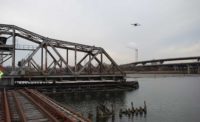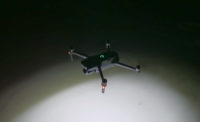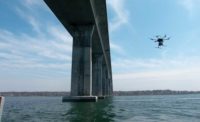City dwellers are accustomed to taxicab stands on bustling street corners, but what will happen to those stands if taxis start to fly?
Although the idea may seem fantastic, it could become an engineering challenge soon. Volocopter, a German manufacturer, and EHang, a Chinese company, are developing unmanned aerial vehicles (UAVs) for an autonomous air taxi project for the Roads and Transport Authority in Dubai. Sheikh Mohammed bin Rashid, Dubai’s ruler, has said that 25% of all transport in the emirate will become autonomous by 2030. Preliminary flight tests of the UAVs already have begun.
EHang’s lightweight vehicle can carry a passenger for up to 10 miles before it needs to recharge. The passenger selects a destination on a touch interface and is whisked away. “You don’t even have to touch the joystick,” the CEO of EHang says in a promotional video with footage of manned flight tests.
John Dotlich, founder of the Indiana-based company Lily Helipads LLC, dedicates much of his time to the creation of safe, eco-friendly helipads. He believes that UAVs could benefit cities through the transport of passengers, merchandise and emergency first responders. These emerging models of rotary aircraft will require “vertiports,” similar to those Lily Helipads constructs. However, there are numerous environmental and safety considerations.
Lily Helipads’ patented design for helipads uses permeable concrete pavements with an engineered H-20 load rating. Fluids such as fuel and deicers drain to a layer of compacted aggregate over a chemical- and petroleum-resistant geomembrane with a watertight bulkhead that directs the flow to an oil separator and an additional “pure product” oil collector.
“For manned or unmanned aircraft, a level surface is always preferred, and our helipads are mostly constructed at ground level or upon a relieving pier at the water’s edge,” says Dotlich.
Dotlich’s design also offers all-weather accessibility for cold climates, with built-in heating coils to ensure that the landing area is free of snow and ice and with a no-slip surface. This could be critical for a system that would include multiple vertiports around a city. “The needs for vertiports will be vast and numerous, located on public and private properties,” says Dotlich.
Joseph E. Cavasinni, a civil engineer, attorney and the head of the construction design and liability practice group at the law firm Reminger Co. LLC, Cleveland, agrees that new facilities will be needed, but he foresees challenges, including economics, liability insurance and regulation.
“It will only be a matter of time before UAVs can be utilized as an effective and viable means of transportation,” Cavasinni says. He points out that a number of companies are developing the technology, including Airbus, Uber and Kitty Hawk, but he says the technology needs to address a number of obstacles that extend beyond functionality and collision avoidance.
“A state or federal agency would likely need to be set up to license UAV operators. Designated routes will have to be developed, including takeoff and landing points,” Cavasinni says. “To be practical, efficient and cost effective, takeoff and landing points would need to be constructed in numerous areas within the city, where available space is an extremely limited commodity that would come at a substantial cost—unless public space could be converted for that purpose. Another option is to establish takeoff and landing points on the roofs of existing buildings—which presents another set of unique challenges.”
Property owners would need to facilitate public access to the roof areas, which could prompt liability, security and noise concerns. There also are the challenges of navigating tight city spaces. The Volocopter 2x has a rotor rim diameter of over 22 ft, while the EHang 184 is just over 13 ft wide.
The EHang 184 is expected to cost between $200,000 and $300,000. The company says it has conducted thousands of test flights since 2014, including a high-speed cruising test that reached 80 mph. But the total cost of an operational service will extend beyond those price tags.
“Unless public space is converted, the costs of land acquisition and construction of takeoff and landing spots, presumably with recharging installations, will be another expense necessarily passed down to the consumer,” says Cavasinni.





Post a comment to this article
Report Abusive Comment